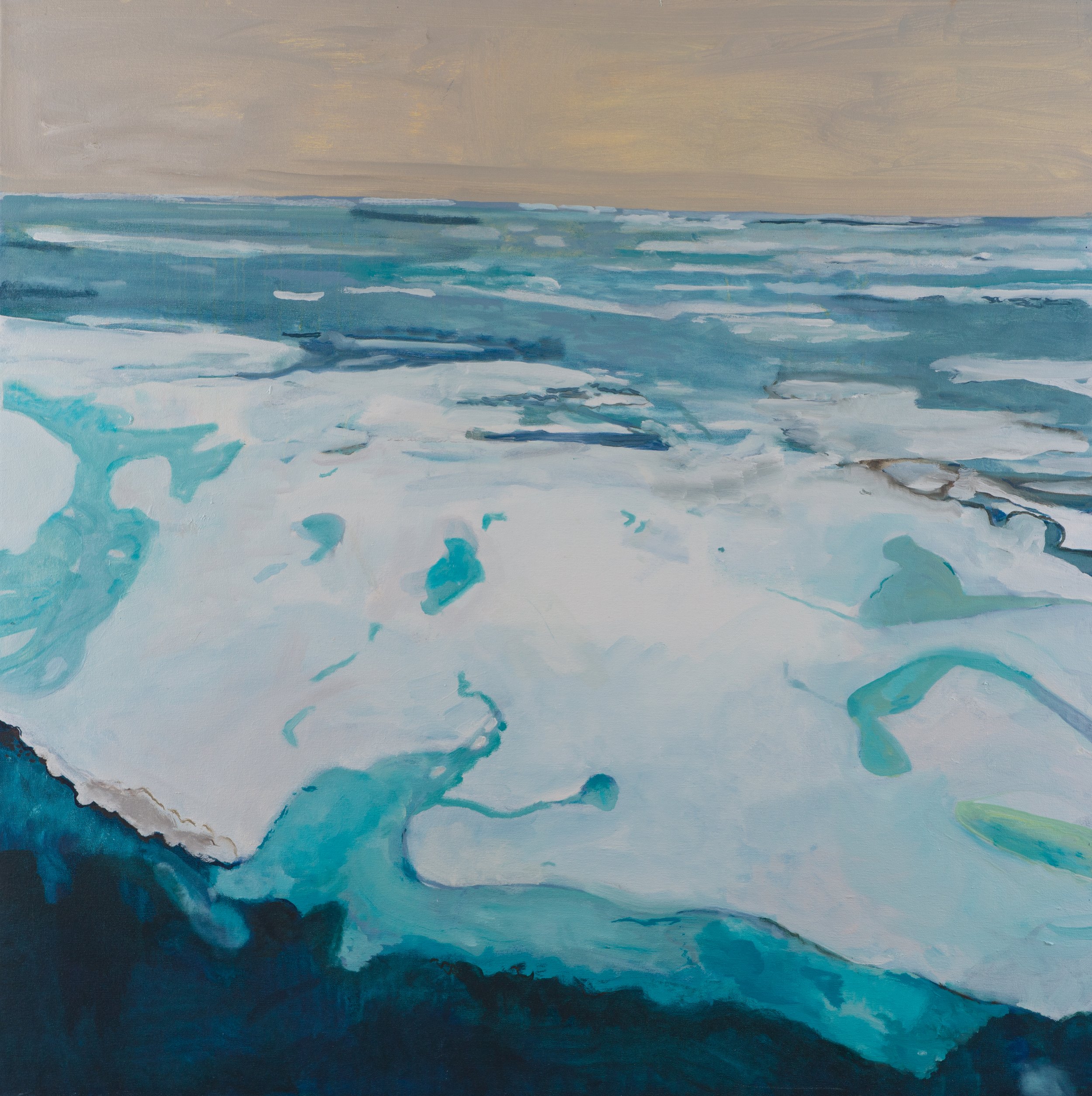
Lesley Burr: Polar North
Da Gadderie, Lerwick
March 10 – May 26, 2024
Lesley Burr exhibited arctic paintings, prints and drawings throughout 2023 in solo exhibitions in Stirling and Dunoon, and in a Glasgow Girls exhibition in London. This exhibition in Lerwick is the last one she currently has planned, and art-scot are delighted to show a small sample.
Introduction by Karen Clubb
Lesley Burr (b. 1963) is a Scottish artist and teacher working primarily in painting, drawing and printmaking. She studied fine art at Glasgow School of Art (1981–1985) followed by an MA in Public Art and Design at Duncan of Jordanstone College of Art & Design, Dundee (1985-86). Lesley is part of the artist group “The Glasgow Girls” and has exhibited widely with both solo and group shows throughout the UK.
Described by Colin R Greenslade, Director, Royal Scottish Academy of Art & Architecture, as “one of our most celebrated artists”, Lesley continues to develop her artistic practice through her ongoing connection with the natural landscape and humankind’s impact on the land.
A period of 10 years living in Shetland, 20 years ago, ignited her long-term interest in ‘the North’ – she has always sought out remote locations and her work has continued to concern her relationship with the natural world. In 2019, she was awarded a residency from Scott Polar Research Institute to travel to the Arctic, and the ‘Polar North’ exhibition is her response to that journey. Her distinctly resolute fine art pieces include large-scale oils, monoprints and ceramics, which form an amazing body of work that are bold and fearless yet sensitive and thought-provoking, connecting the viewer to the environmental issues we collectively face. ‘Polar North’ is very much a life’s work for Lesley, and a long-standing interest in and commitment to the natural environment.
Introduction by Lesley Burr
I have a longstanding interest in nature, and the inter-relationships that exist between people and the surrounding landscape. The Arctic journey has however been a life changing experience. It fulfilled a personal longing to see at first-hand the polar environment and to record a deep affinity with this vast landscape. Although bleak and remote in places, it is home to many people and animals. Over the last 4 years I have been researching and interpreting the imagery and themes that have brought a new focus for my work.
During the 11 day voyage I worked intuitively, spontaneously, with the realisation that time was limited and yet I wanted to make connection of imagery, and symbolism that felt genuine. In the Arctic there are signs that both the human and natural environment is vulnerable to change and increasingly fragile and I wanted to capture a sense of this with a tenderness for the life that inhabits this special place. Climate change is of course a constant backdrop but unexpectedly there is not a sense of hopelessness.
This wish to present vulnerability, fragility and tenderness applies equally to the indigenous and traditional cultures of the Inuit communities as much as to the snow buntings, or the solitary animals in the landscape.
The Arctic landscape took me by surprise: the scale, sounds that were strangely familiar, such as ice against the hull of the ship, possibly remembered from the words and written accounts of the many books I have read on exploration and nature in the arctic.
Above all however, I experienced in this most remote environment, a deep feeling of interconnection for life, animals, plants, people, everything alive, interwoven and inextricably linked. Nothing prepared me for the astounding silence of this place, beyond any previous experience of wilderness I had encountered, immersed in a world only previous imagined. A particular highlight was looking out beyond the vastness of the ice-field in Frobisher Bay, I felt an immense sense of peace, understanding how everyone and everything is interconnected to the surrounding landscape. Prior conversations with the scientific community suddenly made sense, such as the changes to salinity in the water because of increased ice melting, and as the ice reduces there are changes to the microorganisms that feed life in the ocean. The many processes of nature continuing regardless of the human intervention, with many changes remaining hidden from clear view.
Ultimately, I returned from Baffin Island with over 100 sketches and 500 photographs, providing me with valuable source material and recordings that evoke the incredible beauty, and sense of spaciousness. Back in the studio and with the benefit of time and space to fully absorb the experience, the pandemic happened and provided an unexpected quietness to focus on the production of new artwork. I was able to absorb, process and consider imagery, symbolism, iconography, whilst being more experimental and playful with the imagery.
Lesley Burr, The Husky and his Kingdom, 91cm x 120cm, oil on canvas, 2023.
Lesley Burr, Turquoise light over Baffin glacier, Hudson Strait, 91cm x 120cm, Oil on canvas, 2022.
Lesley Burr, Arctic Fox and Inuit Hunter, 31cm x 36cm, monoprint, 2023.
Lesley Burr, Nunavut Inlet, Frobisher Bay, 91cm x 91cm, Oil on canvas, 2021.
Lesley Burr, Nunavut Icefield in July, 2020, 91cm x 91cm, oil on canvas.
Lesley Burr, Vast Nunavut Landscape, 50x65cm, watercolour and graphite, 2019.
Lesley Burr, Scattered Sea Ice, 91cm x 120cm, oil on canvas, 2020.
Lesley Burr, Sea Bear Watching (you don't belong here), 91cm x 91cm, oil on canvas, 2021.
Lesley Burr, Greenland Iceberg in Rose light, 91cm x 91cm, oil on canvas, 2021.
Lesley Burr, Waiting 'Resolute', Zodiac Trip, 32cm x 42cm, oil on board, 2021.
Lesley Burr, The Great Arctic Song, 56cm x 64cm, monoprint, 6/6, 2024.
Lesley Burr, Standing Husky, 21cm x 16cm, oil on primed paper, 2022.
Lesley Burr, Dark Arctic, Frobisher Bay, 40cm x 53cm, monoprint, 2019.
Lesley Burr, Greenland Iceberg under cloudy sky, 56cm x 64cm, monoprint, 2022.
All images are copyright of the artist
With thanks to Lesley Burr, Karen Clubb and Shetland Museum and Archives
















